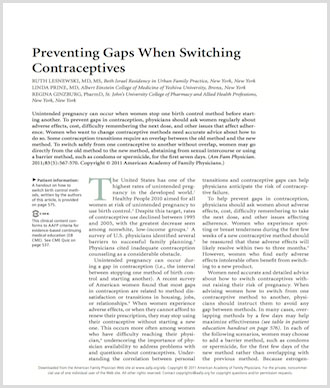Preventing Gaps When Switching Contraceptives
Lesnewski R, Prine L, Ginzburg R.
Am Fam Physician. 2011 Mar 1;83(5):567-570
Link: http://www.aafp.org/afp/2011/0301/p567.html
Abstract
Unintended pregnancy can occur when women stop one birth control method before starting another. To prevent gaps in contraception, physicians should ask women regularly about adverse effects, cost, difficulty remembering the next dose, and other issues that affect adherence. Women who want to change contraceptive methods need accurate advice about how to do so. Some contraception transitions require an overlap between the old method and the new method. To switch safely from one contraceptive to another without overlap, women may go directly from the old method to the new method, abstaining from sexual intercourse or using a barrier method, such as condoms or spermicide, for the first seven days.
The United States has one of the highest rates of unintended pregnancy in the developed world. Healthy People 2010 aimed for all women at risk of unintended pregnancy to use birth control. Despite this target, rates of contraceptive use declined between 1995 and 2005, with the greatest decrease seen among nonwhite, low-income groups. A survey of U.S. physicians identified several barriers to successful family planning. Physicians cited inadequate contraception counseling as a considerable obstacle.


